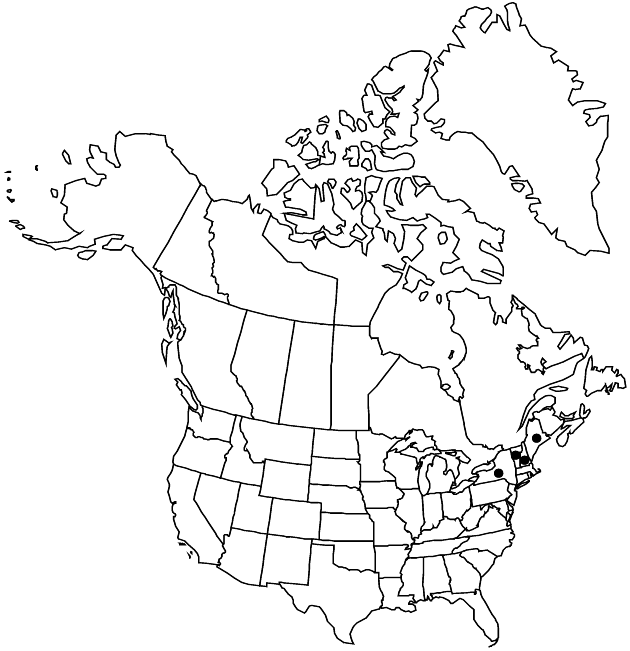Difference between revisions of "Prenanthes boottii"
Syn. Pl. 4: 1309. 1847.
FNA>Volume Importer |
imported>Volume Importer |
||
| (6 intermediate revisions by 2 users not shown) | |||
| Line 8: | Line 8: | ||
}} | }} | ||
|common_names=Boot’s rattlesnakeroot | |common_names=Boot’s rattlesnakeroot | ||
| − | |basionyms={{Treatment/ID/ | + | |special_status={{Treatment/ID/Special_status |
| + | |code=E | ||
| + | |label=Endemic | ||
| + | }}{{Treatment/ID/Special_status | ||
| + | |code=C | ||
| + | |label=Conservation concern | ||
| + | }} | ||
| + | |basionyms={{Treatment/ID/Basionym | ||
|name=Nabalus bootii | |name=Nabalus bootii | ||
|authority=de Candolle | |authority=de Candolle | ||
| + | |rank=species | ||
| + | |publication_title=in A. P. de Candolle and A. L. P. P. de Candolle, Prodr. | ||
| + | |publication_place=7: 241. 1838 | ||
}} | }} | ||
|synonyms= | |synonyms= | ||
| Line 28: | Line 38: | ||
|distribution=Maine;N.H.;N.Y.;Vt. | |distribution=Maine;N.H.;N.Y.;Vt. | ||
|discussion=<p>Of conservation concern.</p><!-- | |discussion=<p>Of conservation concern.</p><!-- | ||
| − | --><p>Prenanthes bootii is recognized by its relatively short, decumbent habit, deltate to hastate proximal leaves, entire or weakly dentate margins, glabrous and blackish green phyllaries, white corollas, and alpine habitat.</p> | + | --><p><i>Prenanthes</i> bootii is recognized by its relatively short, decumbent habit, deltate to hastate proximal leaves, entire or weakly dentate margins, glabrous and blackish green phyllaries, white corollas, and alpine habitat.</p> |
|tables= | |tables= | ||
|references= | |references= | ||
| Line 37: | Line 47: | ||
-->{{#Taxon: | -->{{#Taxon: | ||
name=Prenanthes boottii | name=Prenanthes boottii | ||
| − | |||
|authority=(de Candolle) D. Dietrich | |authority=(de Candolle) D. Dietrich | ||
|rank=species | |rank=species | ||
| Line 51: | Line 60: | ||
|publication title=Syn. Pl. | |publication title=Syn. Pl. | ||
|publication year=1847 | |publication year=1847 | ||
| − | |special status= | + | |special status=Endemic;Conservation concern |
| − | |source xml=https:// | + | |source xml=https://bitbucket.org/aafc-mbb/fna-data-curation/src/2e0870ddd59836b60bcf96646a41e87ea5a5943a/coarse_grained_fna_xml/V19-20-21/V19_365.xml |
|tribe=Asteraceae tribe Cichorieae | |tribe=Asteraceae tribe Cichorieae | ||
|genus=Prenanthes | |genus=Prenanthes | ||
Latest revision as of 19:51, 5 November 2020
Plants 5–25 cm; taproots short, thick, tuberous. Stems decumbent to erect, mottled purple, simple, glabrous proximally, tomentulose distally. Leaves: proximal present at flowering; petiolate (petioles 2–8 cm, not winged); blades ovate to deltate, 2–8 × 0.5–3 cm, bases hastate or sagittate, margins entire or weakly dentate, faces glabrous; distal reduced, elliptic to lanceolate. Heads (10–20) in narrow, racemiform to thyrsiform arrays (nodding). Calyculi of 4–5, dark green to blackish, subulate bractlets 2–5 mm, glabrous. Involucres cylindro-campanulate, 10–11 × 5–6 mm. Phyllaries 8–11, dark green to almost black, lanceolate to subulate, 8–12 mm, faces glabrous. Florets 9–20; corollas white, 7–13 mm. Cypselae light tan to yellow, subcylindric, subterete to angled, 5–6 mm, indistinctly 7–10-ribbed; pappi pale yellow, 6–8 mm. 2n = 32.
Phenology: Flowering Jul–Aug.
Habitat: Alpine areas above treeline, mountains
Elevation: 1500–2000 m
Distribution

Maine, N.H., N.Y., Vt.
Discussion
Of conservation concern.
Prenanthes bootii is recognized by its relatively short, decumbent habit, deltate to hastate proximal leaves, entire or weakly dentate margins, glabrous and blackish green phyllaries, white corollas, and alpine habitat.
Selected References
None.